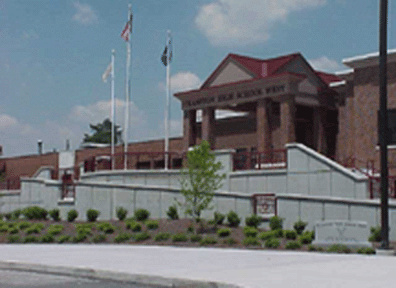Rhode Island teen faces scorn, hate after protesting public school’s prayer
Cranston High School West in Rhode Island was ordered to take down the banner that included a school prayer. (Photo from school website.)
Jessica Ahlquist, a 16-year-old-junior at Cranston High School West, is an outspoken atheist who believes that prayer should not be on display in public schools.
Last month she expressed her views at school board hearing, without effect. But a federal judge recently ruled that Cranston High School cannot display a prayer in its gymnasium, the prayer that Ahlquist has objected too. In retaliation, residents of Cranston, R.I., have threatened Ahlquist. Others, like State Representative Peter G. Palumbo, have called her names including “an evil little thing.”
“It’s something I feel strongly about,” Ahlquist said. “I’m very passionate about my country and the constitution, and as an atheist I like to think I have just as much a right to go to that school and feel included and a piece of that school as any other student who may believe in God.”
The prayer, she said, doesn’t allow for that. It’s huge and entitled “School Prayer.” To her, it said that the school prays, the school believes in God.
“As someone who doesn’t, I don’t really feel like I’m a part of my school,” Ahlquist said.
Ahlquist says she has no problem with people making individual expressions of faith around her — but she objects to a public school having a religious position.
But she’s faced a backlash, like the name-calling, for her views. Kids in school and parents on the Internet have all reached out to harass her.
“Since we actually won, on the Internet I’ve received death threats. There have been nasty, nasty things said, mostly on Twitter, Facebook,” she said.
But there have been other steps. Some are selling T-shirts with the prayer printed on them. And a national group, the Freedom from Religion foundation wanted to send Ahlquist flowers after the victory, but six different local florists refused to make the delivery.
“They eventually found one florist, in Connecticut, who was willing,” Ahlquist said.
Sarah Barringer Gordon, a Professor of History and Constitutional Law at the University of Pennsylvania, said because the prayer is in a school, there’s a very high level of constitutional scrutiny over whether it should remain. Higher even than the hotly debated ability to display a nativity in a public square.
“Courts have traditionally been very concerned about students in public schools who are made to feel that the government actually endorses religion, especially in primary and secondary school,” Ahlquist said.
The prayer contains many strong moral lessons and ethical guidelines. It was put up in 1963 — shortly after the Supreme Court initially ruled that prayers in public schools were not constitutional. Gordon said that decision has been ignored in many places, in many jurisdictions, and remains prevalent across the nation.
“It’s one of the most constantly resisted forms of judicial mandate,” Gordon said. “I find it ironic that Rhode Island, that was founded by a religious dissenter, Roger Williams, is now such a place of orthodoxy.”
